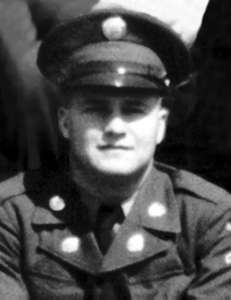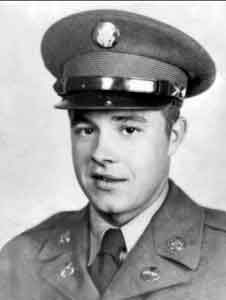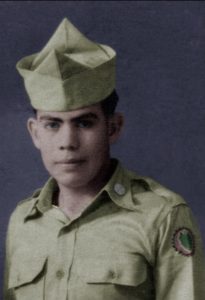Boyd E. Cox from Kentucky, Whitley county.
Service era: Korea
Date of death: Wednesday, July 5, 1950
Death details: On July 5, 1950, Task Force Smith, the first U.S. ground element to engage North Korean People’s Army (NKPA) troops, was defending a position north of Osan, South Korea. The Task Force’s goal was to delay enemy forces by blocking their movement down the road south from Suwon to Taejon, which was a major avenue of advance for the NKPA. That morning, the Task Force was engaged by a column of enemy tanks. The anti-tank weapons that the infantrymen employed were ineffective, and a large number of tanks broke through their position. Task Force Smith was forced to withdraw to the south, suffering heavy casualties in the process. Corporal Boyd Edward Cox, who joined the U.S. Army from Kentucky, served with B Company, 1st Battalion, 21st Infantry Regiment, 24th Infantry Division. His unit was part of Task Force Smith, and he was captured by enemy forces on July 5 and marched north with other prisoners. He died near Yonchon, South Korea, while en route to the Apex prison camps in North Korea. Searches for his remains have been unsuccessful, and he is still unaccounted for. Today, Corporal Cox is memorialized on the Courts of the Missing at the National Memorial Cemetery of the Pacific.
Source: National Archives, Defense POW/MIA Accounting Agency

 Death details: Accounted for in 2022. On July 5, 1950, Task Force Smith, the first U.S. ground element to engage North Korean People’s Army (NKPA) troops, was defending a position north of Osan, South Korea. The Task Force’s goal was to delay enemy forces by blocking their movement down the road south from Suwon to Taejon, which was a major avenue of advance for the NKPA. That morning, the Task Force was engaged by a column of enemy tanks. The anti-tank weapons that the infantrymen employed were ineffective, and a large number of tanks broke through their position. Task Force Smith was forced to withdraw to the south, suffering heavy casualties in the process. Corporal Alton Christie, who joined the U.S. Army from Florida, was a member of B Company, 1st Battalion, 21st Infantry Regiment, 24th Infantry Division. He was a member of Task Force Smith, and he was lost at some point during the fighting on July 5, 1950. CPL Christie was never reported as a prisoner of war. In 1950, a set of remains was found in the Osan battle area of South Korea, bearing a clothing marker associated to CPL Christie. The remains were declared unidentifiable and buried in the National Memorial Cemetery of the Pacific, under X-file 214 (Taejon), and are now under analysis at the Defense POW/MIA Accounting Agency (DPAA). CPL Christie is still unaccounted-for. Today, Corporal Christie is memorialized on the Courts of the Missing at the National Memorial Cemetery of the Pacific.
Death details: Accounted for in 2022. On July 5, 1950, Task Force Smith, the first U.S. ground element to engage North Korean People’s Army (NKPA) troops, was defending a position north of Osan, South Korea. The Task Force’s goal was to delay enemy forces by blocking their movement down the road south from Suwon to Taejon, which was a major avenue of advance for the NKPA. That morning, the Task Force was engaged by a column of enemy tanks. The anti-tank weapons that the infantrymen employed were ineffective, and a large number of tanks broke through their position. Task Force Smith was forced to withdraw to the south, suffering heavy casualties in the process. Corporal Alton Christie, who joined the U.S. Army from Florida, was a member of B Company, 1st Battalion, 21st Infantry Regiment, 24th Infantry Division. He was a member of Task Force Smith, and he was lost at some point during the fighting on July 5, 1950. CPL Christie was never reported as a prisoner of war. In 1950, a set of remains was found in the Osan battle area of South Korea, bearing a clothing marker associated to CPL Christie. The remains were declared unidentifiable and buried in the National Memorial Cemetery of the Pacific, under X-file 214 (Taejon), and are now under analysis at the Defense POW/MIA Accounting Agency (DPAA). CPL Christie is still unaccounted-for. Today, Corporal Christie is memorialized on the Courts of the Missing at the National Memorial Cemetery of the Pacific. Death details: On July 5, 1950, Task Force Smith, the first U.S. ground element to engage North Korean People’s Army (NKPA) troops, was defending a position north of Osan, South Korea. The Task Force’s goal was to delay enemy forces by blocking their movement down the road south from Suwon to Taejon, which was a major avenue of advance for the NKPA. That morning, the Task Force was engaged by a column of enemy tanks. The anti-tank weapons that the infantrymen employed were ineffective, and a large number of tanks broke through their position. Task Force Smith was forced to withdraw to the south, suffering heavy casualties in the process. Private First Class Alfred Charles Bordeau, who joined the U.S. Army from Michigan, served with C Company, 1st Battalion, 21st Infantry Regiment, 24th Infantry Division. His unit was part of Task Force Smith, and he was captured by enemy forces on July 5, just north of Osan, South Korea. He was forced to march north to the Apex prison camps near the Yalu River, and died of exhaustion and malnutrition at the camp near Kaeyambol in May or June of 1951. Although he was buried nearby, his remains were not identified among those returned to U.S. custody after the ceasefire. Today, Private First Class Bordeau is memorialized on the Courts of the Missing at the National Memorial Cemetery of the Pacific.
Death details: On July 5, 1950, Task Force Smith, the first U.S. ground element to engage North Korean People’s Army (NKPA) troops, was defending a position north of Osan, South Korea. The Task Force’s goal was to delay enemy forces by blocking their movement down the road south from Suwon to Taejon, which was a major avenue of advance for the NKPA. That morning, the Task Force was engaged by a column of enemy tanks. The anti-tank weapons that the infantrymen employed were ineffective, and a large number of tanks broke through their position. Task Force Smith was forced to withdraw to the south, suffering heavy casualties in the process. Private First Class Alfred Charles Bordeau, who joined the U.S. Army from Michigan, served with C Company, 1st Battalion, 21st Infantry Regiment, 24th Infantry Division. His unit was part of Task Force Smith, and he was captured by enemy forces on July 5, just north of Osan, South Korea. He was forced to march north to the Apex prison camps near the Yalu River, and died of exhaustion and malnutrition at the camp near Kaeyambol in May or June of 1951. Although he was buried nearby, his remains were not identified among those returned to U.S. custody after the ceasefire. Today, Private First Class Bordeau is memorialized on the Courts of the Missing at the National Memorial Cemetery of the Pacific. Death details: On July 5, 1950, Task Force Smith, the first U.S. ground element to engage North Korean People’s Army (NKPA) troops, was defending a position north of Osan, South Korea. The Task Force’s goal was to delay enemy forces by blocking their movement down the road south from Suwon to Taejon, which was a major avenue of advance for the NKPA. That morning, the Task Force was engaged by a column of enemy tanks. The anti-tank weapons that the infantrymen employed were ineffective, and a large number of tanks broke through their position. Task Force Smith was forced to withdraw to the south, suffering heavy casualties in the process. Private First Class Anselmo Zamora, who joined the U.S. Army from Texas, served with B Company, 1st Battalion, 21st Infantry Regiment, 24th Infantry Division. His unit was part of Task Force Smith, and he was captured by enemy forces on July 5. He was forced to march to the Apex prison camps in North Korea, and died of malnutrition at the camp at Hanjang-ni on February 24, 1951. He was buried near the camp; however, his remains were not identified among those returned to U.S. custody after the ceasefire. Today, Private First Class Zamora is memorialized on the Courts of the Missing at the National Memorial Cemetery of the Pacific.
Death details: On July 5, 1950, Task Force Smith, the first U.S. ground element to engage North Korean People’s Army (NKPA) troops, was defending a position north of Osan, South Korea. The Task Force’s goal was to delay enemy forces by blocking their movement down the road south from Suwon to Taejon, which was a major avenue of advance for the NKPA. That morning, the Task Force was engaged by a column of enemy tanks. The anti-tank weapons that the infantrymen employed were ineffective, and a large number of tanks broke through their position. Task Force Smith was forced to withdraw to the south, suffering heavy casualties in the process. Private First Class Anselmo Zamora, who joined the U.S. Army from Texas, served with B Company, 1st Battalion, 21st Infantry Regiment, 24th Infantry Division. His unit was part of Task Force Smith, and he was captured by enemy forces on July 5. He was forced to march to the Apex prison camps in North Korea, and died of malnutrition at the camp at Hanjang-ni on February 24, 1951. He was buried near the camp; however, his remains were not identified among those returned to U.S. custody after the ceasefire. Today, Private First Class Zamora is memorialized on the Courts of the Missing at the National Memorial Cemetery of the Pacific.